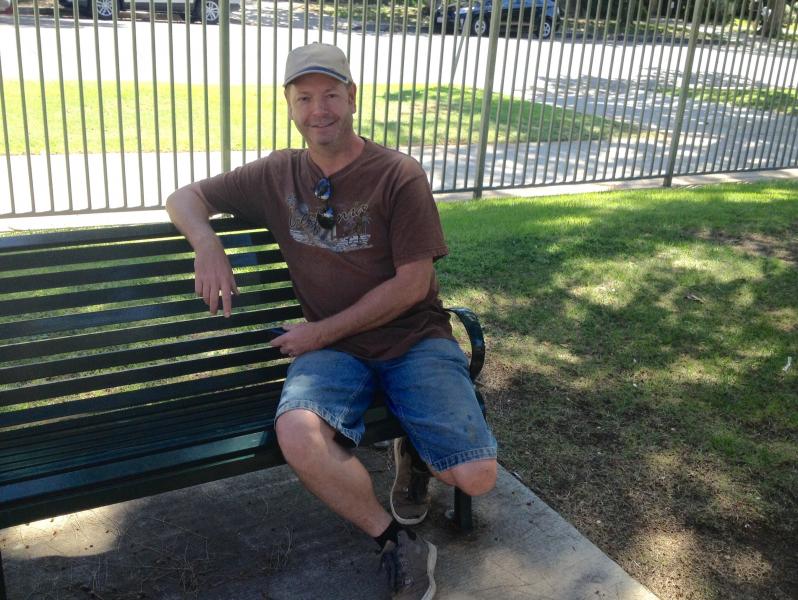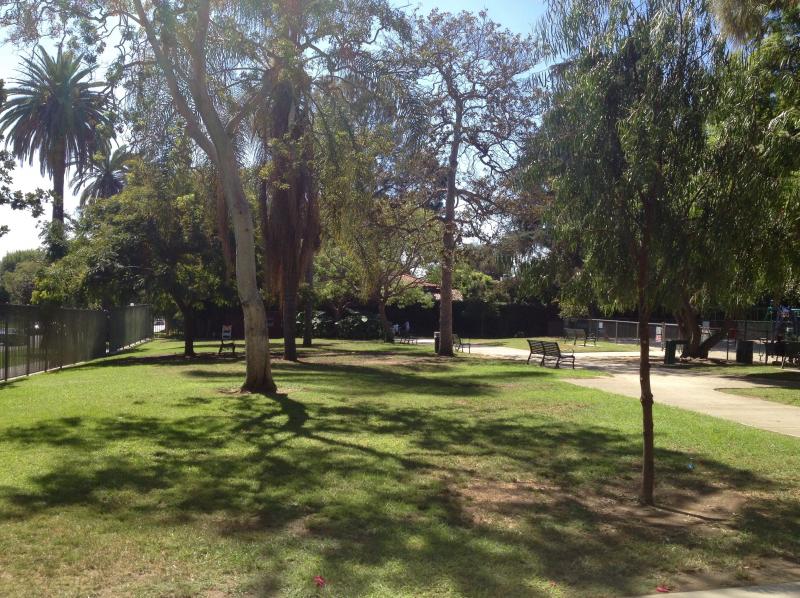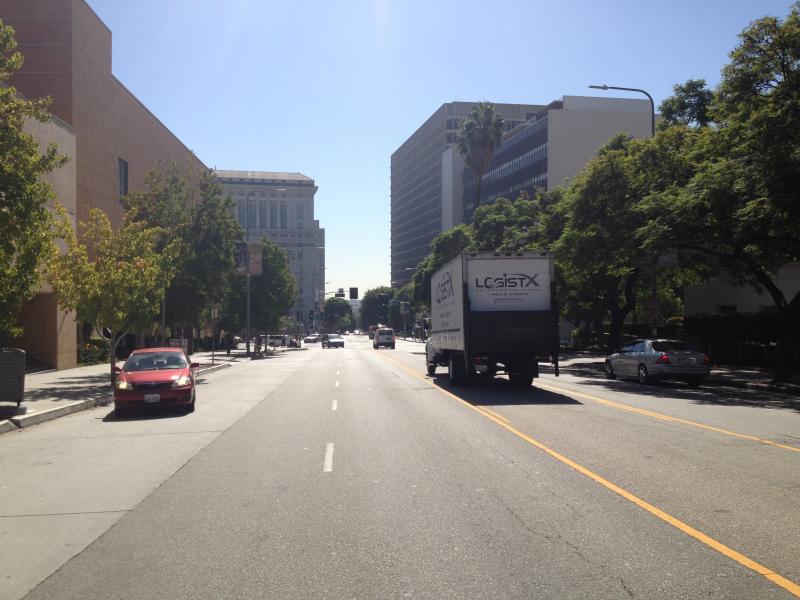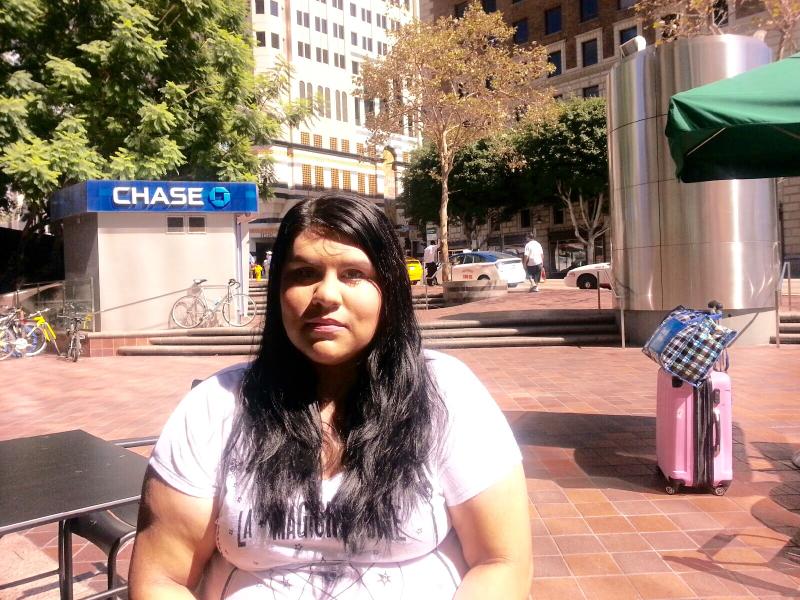Los Angeles' Water Conservation: More Wet Handshake Than Iron Fist
(Story originally published October 8th 2014.)
Los Angeles landscaper, Paul Viers can feel his frustration rising.
It’s a warm Monday afternoon between two heat waves. The Beverly Boulevard traffic dawdles past Burns Park as a handful of mothers watch their children play on the mostly green grass. There is a golf course down the street.
“That’s a big patch of land over there,” Viers says, motioning in the direction of the lush country club. “It’s almost three acres, and they water it every night. But it’s for rich people. That’s what pisses me off.”
This is out-of-keeping with the sunny motto on his business card, which says he is “making the world beautiful one garden at a time.”

Viers has been holding court for the past half hour on the California drought. “It's allowed me to say to my clients 'look, you can have a beautiful garden and use a third or even a fifth or sixth of the water you're using.'”
He is one of a growing chorus of environmentally-minded Californians who feel that many of the government's initiatives to combat the worsening drought have been too little too late.
The last day of September marked the end of the official water year. After three consecutive years of drought, the past year was one of the driest on record. The state has entered its fourth year of drought with less than 60 percent of the average rainfall, according to the California Department of Water Resources. California's major reservoirs now hold less than 57 percent of the usual average.
Programs such as the L.A. County’s Cash For Grass program, which are designed to combat the effects of the drought, mean that Viers is as busy as he has been in 15 years of landscaping.
Thanks to Cash For Grass, Los Angeles County is effectively paying for his services. The rebate of up to three dollars per square foot is available to citizens who rip out their lawns. Viers then replaces them with varying combinations of gravel, cacti and California-native plants.
“People before who probably weren't concerned, are now concerned. I’d say 65 percent of my clients now realize that having grass is a waste of water,” he said.
Those same local authorities, though, have been slow to act and inconsistent in its message, he says, adding that some public agencies are among the offenders.
"The DWP [Department of Water and Power] - you always just see the sprinklers running everywhere on the side of the roads, in the parks, golf courses,” Viers said. “They’re the ones wasting more water than the private consumers. It’s city water and they’re just wasting it.”
Viers’ concern stems from a perceived soft-selling of conservation methods to the public. As of late August, the DWP had not handed out a single drought-related fine.
The Cash For Grass lawn rebate program was only brought in in June of this year.
Rebates
“They [the DWP] have pioneered a lot of things that have saved a lot of water,” freelance science journalist, Kit Stolz said. The freelance science journalist pointed to rebate-motivated low-flow toilets and shower-heads. But these schemes as well are voluntary, and official figures on those using them are in short supply.
“I’ve been doing this a long time and I’ve never seen California this dry in ten years,” says Viers. “It’s a little bit startling and scary, but it's also a good opportunity for landscapers to help people with the environment.”
Even those who choose to keep their lawns are taking drought-reduction measures, says Viers. “I’m changing a lot of sprinkler systems, so people before had these gi-normous sprinkler systems that really wasted water. Now, they have me installing drip systems.It's been good for business, so I’m not complaining,” he laughed.
There is nothing funny, though, about Californians’ attachment to their lawns.

Lawn Love
A 2011 study from the Public Policy Institute of California suggests that almost half of California’s urban water is used for landscaping. The PPIC report says that 37 percent of urban water is used for ‘residential exteriors,’ while a further 10 percent is used for ‘large landscaping.’
NASA climatologist Bill Patzert went further, referring to total water use.“We’re somewhere like 140 gallons per day per person. Australians use 80 gallons per day per person."
“Sixty percent of the water-use for single family households is in our yards,” he continued. “They have to use less. In many areas now, they’re taking out the English lawn and garden.”
Patzert criticized the authorities’ lack of urgency. If California sees another year of drought, he said, "we’re not going to be talking about voluntary conservation.”
Environmental journalist Kit Stolz, who facilitates panel discussions about water conservation, says the relaxed attitude can’t last much longer. “I went to a meeting in June for the California Association of Water Agencies, and I was surprised that water managers were not as concerned, panicked, alarmed as they might be after two and a half years of drought.”
The county’s department for recreation and parks, which is responsible for watering Los Angeles’ golf courses and parks, decline to comment.
There are those in the local government who are aware of the extremity of the situation. “We live in a semi-arid climate,” said Shahram Kharaghani, Watershed Protection Program Manager the Department of Public Works. “We need to change our attitude and quickly. I meet on a monthly basis with the Department of Recreation and Parks. I talk to them about how they could minimize water consumption.”
But Kharaghani said it is still unclear as to what precise action the government is planning to take.
Slide The City
Kharaghani works closely with the Los Angeles Department of Planning - the same department responsible which revoked the permit of the highly-anticipated Slide The City event.
The 1000-foot long slip and slide was due to be held in Downtown, Los Angeles at the end of September. Locations on Figueroa Street and Grand Street were touted as possible locations.

“One of the issues was using water during the drought for recreational purposes,” said Kharaghani.
Slide The City founder, John Malfatto agrees that PR concerns were largely behind the event’s cancellation. “It really did start of with the drought,” he said. According to his email signature, Malfatto has styled himself the President of Soap Application. “Their [the City’s] concern is that is doesn't really promote the water saving that the state of California is trying to do.”
A petition launched by Cerritos College student Karina Soto helped scuttle the event. “I had read an article about it and my initial reaction afterwards was that I was really upset as to why the City would event consider hosting the event,” says Soto.
Soto created her online petition at 2 a.m. and by the following morning she had 300 signatories. By the time the Slide the City event had its permit revoked, almost 11,000 people had signed up to oppose it.
The slide was cancelled only nine days before it was to take place, largely due to media coverage that linked it to the drought.
“They didn't want to give approval to an event that looked so much like wasting water, even though we were wasting a significant amount less than, say, a golf course in a day,” said organizer Malfatto.

Malfatto said there had been plans to dechlorinate the water and donate it to Los Angeles’ Griffith Park. “I think they were a little misinformed. I think if they really looked into it, they would see that we wouldn’t really waste the water,” he said, of the city’s decision.
A spokesman for Griffith Park said he was unaware of any plan to receive donated water from the event.
The authorities’ slow reaction to the drought at large, seems to be mirrored by a slow change in attitudes towards water conservation. “I’m rich, this is my property, I can do whatever I want,” says Viers, is the attitude of some of his wealthier clients?.
If and when the water does run out, it will indeed be the rich who can do what they want.
“I fear we will start to see the same inequalities we see with money will be reflected with water. People who have lots of money will be able to come up with water via truck or well,” Kit Stolz said.
"In the very wealthy communities like Beverly Hills and many places in Orange County, people don’t flinch at their water bills and they’re willing to pay,” said Bill Patzert. “Many of these places look like rain forests.”
This failure to take personal responsibility may be one of Los Angeles’ largest barriers to efficient water conservation.
“If we go into next year with the fourth year of severe drought, we’re not going to be asking for a voluntary conservation," continues Patzert. "The conversation is going to be very different.”
Aside from Paul Viers’ booming business and the tickets which Slide the City have had to refund, experts and locals paint a picture of water conservation efforts which have so far seemed superficial.
As faucets start to run dry across the state of California, local authorities will need to do far more than just coax a concerned majority with lawn rebates and fear-mongering headlines.



